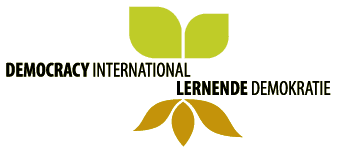Democracy is more than elections and politicians. It can only succeed if the entire society and its environment are included. The Democracy Policy Canvas visualizes this in a flow diagram: our democratic society is like a large garden that needs watering. The water in our garden—and in our democracy—must flow, analogous to communication and participation. If the water reaches even the farthest corners, our society can thrive and bear abundant fruit—not only for our generation but also for distant and future ones.
The democracy model identifies 12 interfaces—critical points and channels that are particularly important for the sustainable functioning of our democracy. However, there is a gap that must be bridged, deliberately built into our political model: while we (the people) are formally the sovereign (Article 20, Paragraph 2 of the German Basic Law), we relinquish this power with our vote. The role of parties, associations, and the media is to help bridge this representation gap between elections. Yet this does not always work well and is often insufficient. The flourishing of a democratic society depends not only on passing good laws (§) but also on fostering forms of cross-societal collaboration (co-production of the common good).
When and how can this canvas be used? It can help make your project more politically relevant and enable you to engage
where the democratic value-creation process needs support. How? By discussing and marking areas where participation and
collaboration in your community work well or poorly: Where is it stuck (red), and where does it flow (blue)
Democracy policy focuses on ensuring the sustainable and effective functioning of the complex interplay between all actors and interfaces. It goes beyond simply ensuring the smooth functioning of the political opinion-forming and legislative processes (interfaces 1–4). Instead, it encourages taking detours to include those who are either too close to or too distant from power (interfaces 5–7). For the sustainable development of our community, it is also essential to look outward—into the distance and the future (interfaces 8–11). How can we ensure that even future generations are included? Within our multi-layered democracy cycle, the task of ensuring that all these elements work effectively and are continuously improved becomes the core responsibility of sustainable policy.
Shaping democracy policy is an important task that concerns and challenges all of us—including every sustainability initiative. With the help of this canvas, you can keep the following interfaces in mind and position your project accordingly:
- Consulting (Preliminary Participation) How do we get our concerns onto the agenda? How do we make our voices heard?
- Collaborating (Subsequent Participation) How do we learn about and become involved in political implementation?
- Coordinating (Internal Administrative Cooperation) How can administrative units and government bodies work better together?
- Cooperating (Collaboration Within Society) How do we, as a state, tackle issues through our engagement and initiative?
- Activating (Marginalized/Underrepresented Groups) How do we reach those who cannot or do not come forward on their own?
- Assisting (Inclusion of Political/Administrative Leaders) How can we ensure the genuine and reliable participation of those in power?
- Incorporating (Inclusion of Influential Actors in Economy, Media, and Society) Similar to point 6, but focusing on the powerful actors in society!
- Federalizing (Organizing Vertical Cooperation) How do political levels collaborate better across boundaries?
- Projecting (Intergenerational Vision) How do we bring the future into today’s decisions?
- Reflecting (Tradition and Heritage in Focus) How do we engage with the past mindfully and learn from it?
- Digitizing (Shaping Digitalization) How do we use digital opportunities to serve the common good?
- Orchestrating (Development and Overall Coordination) How is the interplay between all these interfaces maintained and improved?
You can find the German Canvas here.
You can find the English Canvas here.
You can find the Spanish Canvas here.

